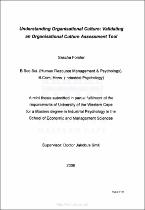| dc.description.abstract | For decades, social science scholars have sought one, all-encompassing framework with which to describe and measure organisational culture. Recently, this search led one particular government institution to create its own organisational culture model, with its own assessment tool. The aim of this research is to present scientific inquiry into the psychometric properties of this organisational culture assessment tool, which has been dubbed the X Model of Organisational Culture Assessment Tool (Smit, Ludik, & Forster, 2006). To understand Smit et al.'s (2006) Organisational Culture Assessment Tool, it is important that one understands the concept of organisational culture. This thesis thus explores some of the organisational culture definitions, models and perspectives that exist within literature today. The cultural elements proposed within Smit et al.'s (2006) X Model of Organisational Culture may not necessarily be unique, but their empirical relationship has yet to be established. The research reported in this thesis therefore endeavoured to empirically illustrate that organisational culture can indeed be characterised by inter-related concepts such as Leadership, Strategy, Adaptability, Coordination, Relationships, and Climate. Using the responses from a pilot study, this project used a quantitative research methodology to evaluate whether Smit et al.'s (2006) Organisational Culture Assessment Tool demonstrates: a high measure of reliability, and statistical validity. It was found that the items, which were assumed to denote Leadership, Strategy, Adaptability, Coordination, Relationship and Climate significantly, represented those respective constructs and/or elements (as revealed by the item analysis which clearly positioned the organisational culture assessment tool as being scientifically reliable). ln addition, the factor analysis also revealed that respondents were seeing things in a particular pattern. Here, these results showed the emergence of eight distinct clusters, namely; a general factor (assumed to denote Culture), Leadership, Relationships, Strategy, Adaptability and Climate thus demonstrating interim support for the questionnaire's underlying theoretical structure (that is, that there are positive signs of validity). Several recommendations are made, the most prominent being that further statistical analysis be conducted using structural equation modelling which would allow for the improvement of this study's' current validity statistics. A further recommendation would include the conducting of covariance structure analysis on a bigger sample group, which would help to lift out the relationships between such elements as Leadership, Strategy, Adaptability, Coordination, Relationsh ips, Climate, Business Performance Indicators, and Forces. | en_US |

